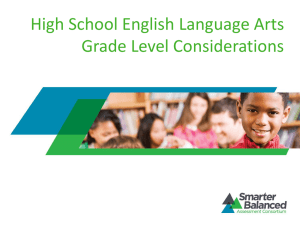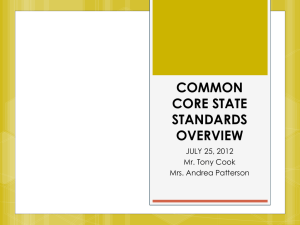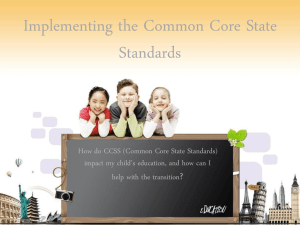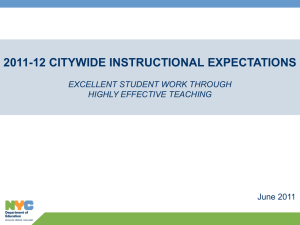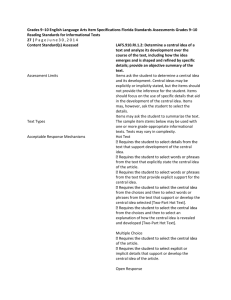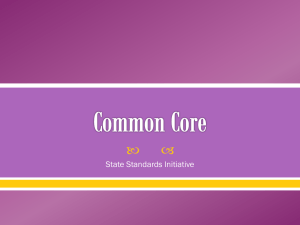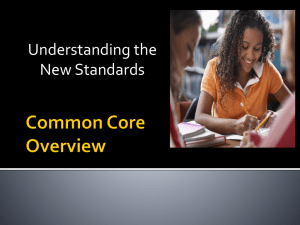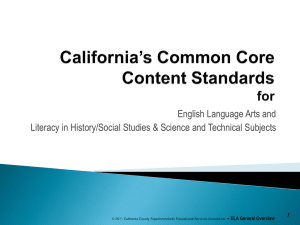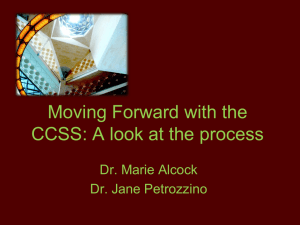February 19, 2014 DELAC Powerpoint Presentation
advertisement
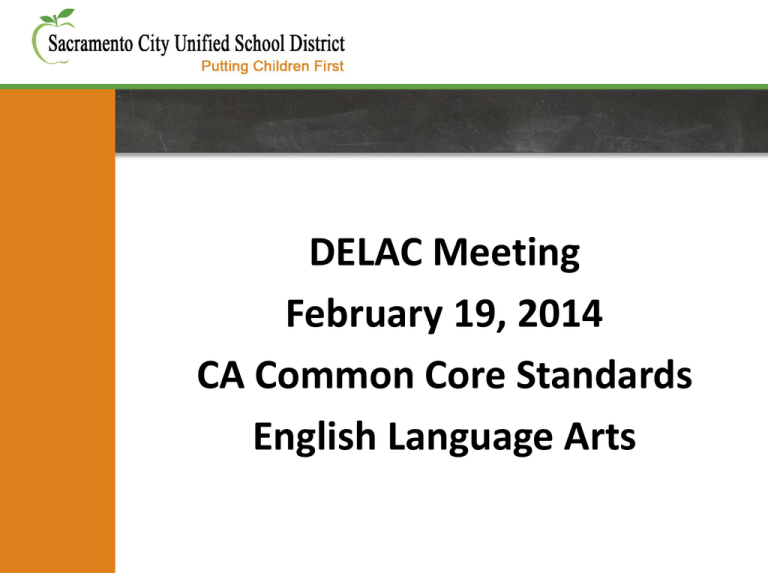
DELAC Meeting February 19, 2014 CA Common Core Standards English Language Arts What are the Common Core Standards? 1. Specify learning expectations for students in grades K-12 2. Consists of two sets of standards a. English Language Arts b. Mathematics 3. Focus on college and career readiness 4. Adopted in 45 states in the US 5. Implemented in 2014-2015 school year 2 Shifts in ELA/Literacy 3 Shift 1 Balancing Informational & Literary Text Students read a true balance of informational and literary texts. Shift 2 Knowledge in the Disciplines Students build knowledge about the world (domains/ content areas) through TEXT rather than the teacher or activities Shift 3 Staircase of Complexity Students read the central, grade appropriate text around which instruction is centered. Teachers are patient, create more time and space and support in the curriculum for close reading. Shift 4 Text-based Answers Students engage in rich and rigorous evidence based conversations about text. Shift 5 Writing from Sources Writing emphasizes use of evidence from sources to inform or make an argument. Shift 6 Academic Vocabulary Students constantly build the transferable vocabulary they need to access grade level complex texts. This can be done effectively by spiraling like content in increasingly complex texts. English Language Arts Standards – Organized into 5 strands in K-12 • • • • • Reading: Literature Reading: Informational Text Writing Listening and Speaking Language – In grades K-5 only: Reading Foundations – In grades 6-12 only: Literacy in History/Social Studies, Science, and Technical Subjects English Language Arts Standards • • • • • Reading Literature (10) Reading Informational Texts (10) Writing (10) Speaking and Listening (6) Language (6) 5 A Closer Look at the ELA Standards • Reading: Literature and Informational Texts – Key Ideas and Details (3) – Craft and Structure (3) – Integration of Knowledge and Ideas (3) – Range of Reading and Text Complexity (1) 6 Key ideas and Details OLD In the story “The Captive” the author shows that Bessie is: NEW After Reading “The Captive,”students respond to this question in writing: a) Mean b) Caring c) Selfish d) Understanding The author shows that Bessie is a caring person. Write a paragraph telling how Bessie is caring. Use specific details from the story to support your answer. Key Ideas and Details K-8 Kindergarten First Grade Second grade 1. With prompting and support, ask and answer 1. Ask and answer questions about key details in 1. Ask and answer such questions as who, what, where, when, why, and how to demonstrate questions about key details in a text. a text. understanding of key details in a text. Third Grade Fourth Grade Fifth Grade 1. Ask and answer questions to demonstrate 1. Refer to details and examples in a text when understanding of a text, referring explaining what the text says explicitly and explicitly to the text as the basis for the when drawing inferences from the text. answers. 1. Quote accurately from a text when explaining what the text says explicitly and when drawing inferences from the text. Grade 6 Students Grade 7 Students Grade 8 Students 1. Cite textual evidence to support analysis of what the text says explicitly as well as inferences drawn from the text. 1. 1. Cite several pieces of textual evidence to support analysis of what the text says explicitly as well as inferences drawn from the text. Cite the textual evidence that most strongly supports an analysis of what the text says explicitly as well as inferences drawn from the text. Key Ideas and Details What is similar and different from grade level to grade level? Craft and Structure “I ask every American to commit to at least one year or more of higher education or career training. This can be community college or a fouryear school; vocational training or an apprenticeship. But whatever the training may be, every American will need to get more than a high school diploma.” --President Barack Obama Craft and Structure 1) Locate the repeated phrase in President Obama’s quote. Why did he repeat it? What effect does it have? 2) The president said: “I ask every American to commit to at least one year or more …” How would the speech have changed if the president had said, “Every American must commit to at least one year or more…” Why did he choose to say it the way he did? Similarities and Differences How is this type of reading similar or different from the reading you had to do in school? Writing There are three types of writing in the CCSS, K-12 1. Opinion/Argument 2. Informational/Explanatory 3. Narrative (Story) A. Opinion/argument B. Informational/Explanatory C. Narrative (Story) Usually, this type of writing … 1. 2. 3. 4. 5. 6. 7. 8. Has characters and a problem ___ Works to persuade someone ___ Is what we call “a report” ___ Follows a chronological (time) structure ___ Is the most common writing used at work ___ Provides counter arguments ___ Follows a main idea/detail structure ___ Uses evidence and examples to support ideas __ English Language Arts Standards – Organized into 5 strands in K-12 • • • • • Reading: Literature Reading: Informational Text Writing Listening and Speaking Language Listening and Speaking College and Career Readiness Anchor Prepare for and participate effectively in a range of conversations and collaborations with diverse partners, building on others’ ideas and expressing their own clearly and persuasively. Apply knowledge of language to understand how language functions in different contexts, to make Standards effective choices for meaning or style, and to comprehend more fully when reading or listening. Language College and Career Readiness Anchor Apply knowledge of language to understand how language functions in different contexts, to make effective choices for meaning or style, and to comprehend more fully when reading or listening. Acquire and use accurately a range of general academic and domain-specific words and Standards phrases sufficient for reading, writing, speaking, and listening at the college and career readiness level; Transition to CCSS: Instruction • Professional development for teachers and administrators • Supplemental materials for the classroom 2014-15 • Revision to the Report Cards (2014-2015) Transition to CCSS: Testing New state assessment system: CA Assessment of Student Performance and Progress (CAASP), which includes the Smarter Balanced Assessment. The Smarter Balanced Assessments are: • For all students Grades 3-8; grades 9-10 • Computerized • Computer adaptive- Will adjust for students’ levels • More difficult that the CST- includes performance (writing) tasks and using several pieces of text for one task How You Can Support Your Child • Read the standards for your children’s grade levels so you know what to expect in their learning. Helpful web sites to Google: Parent Roadmaps to the CCSS– CGCS* PTA CCSS* Achieve the Core Engage NY * Spanish available • Ask specific questions about school, such as What book or story are you reading in English? What type of writing are you doing? What is your homework (in math or reading ) tonight? • Support your child in reading a balance of literary and informational texts. Sources for books are: Library (city, school, classroom), Thrift stores, Yard sales • Keep in contact with the teacher. Make an appointment or send an email. Ask specific questions, like “Is my child understanding what s/he reads? Can my child summarize? Can my child provide evidence for his/her arguments? Specific questions will help you help your child. Table Talk How can you support your child’s English/Language Arts success? Questions

